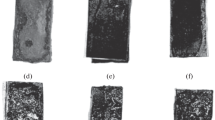Abstract
Tempering of superhard ceramics based on blende boron nitride after the final mechanical treatment and finishing improves the statistics of the cutting properties and provides their stabilization. The correlation between the electrical resistivity of the composites and their wear resistance makes it possible to decrease the cost of monitoring and testing batches of composites in complex evaluation of the cutting properties by reducing the number of endurance tests.
Similar content being viewed by others
References
M. M. Believ, A. M. Keda, V. P. Mikhalev, V. A. Saltykov, and G. A. Nuzhdin,“A superhard composite material, RF Patent No. 2108404,”Izobr, No. 10 (1998).
V. B. Shipilo, E. M. Plyshevskaya, and N. A. Shishonok,“Effect of annealing on the electrophysical properties of a boron nitride composite alloyed with silicon,”Izv. Akad. Nauk BSSR, Ser. Fiz.-Mat. Nauk, No. 4,114–117 (1980).
I. Yu. Sirotin, A. Yu. Mollaev, and R. N. Gadzhiev,“Effect of the heating temperature on the cutting properties of Tomala-10,” in:Modern Technological Methods of Improving the Quality of Machines, Coll. of Works [in Russian], Inst. Fiz. Dagest. Fil. Akad. Nauk, Makhachkala (1992), pp. 81–85.
Author information
Authors and Affiliations
Rights and permissions
About this article
Cite this article
Nuzhdina, E.M. Stabilization of the properties of superhard composites based on blende boron nitride by tempering. Refract Ind Ceram 40, 208–210 (1999). https://doi.org/10.1007/BF02762285
Issue Date:
DOI: https://doi.org/10.1007/BF02762285




